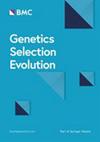Genetic correlations of environmental sensitivity based on daily feed intake perturbations with economically important traits in a male pig line
IF 3.1
1区 农林科学
Q1 AGRICULTURE, DAIRY & ANIMAL SCIENCE
引用次数: 0
Abstract
Pigs in intensive production systems encounter various stressors that negatively impact their productivity and welfare. The primary aim of this study was to estimate the genetic correlations of the slope (indicator of sensitivity of the animals to environmental challenges) of the daily feed intake (DFI) across different environmental gradients (probability of the occurrence of a challenge on a given day) with growth, feed efficiency, carcass, and meat quality traits using a single-step reaction norm animal model (RNAM) in Piétrain pigs. In addition, genetic correlations of DFI (its total breeding value) with the same traits were also estimated. The probabilities of the occurrence of an unrecorded environmental challenge, inferred via a Gaussian mixture model, were taken as a reference and used in the genetic analysis as an environmental descriptor. Variance components were estimated via restricted maximum likelihood using the single-step genomic best linear unbiased prediction method, using a series of multivariate RNAM with two phenotypes (DFI and each of the traits of economic importance), with the probability of an unrecorded challenge on a given day included as an environmental descriptor for DFI only, because DFI is recorded daily but the other traits are not. Genetic correlations of the slope of DFI were 0.15 with age at 100 kg, 0.04 with backfat thickness, − 0.29 with loin muscle thickness, 0.05 with feed conversion ratio, − 0.07 with lean meat percentage, − 0.13 with pH of the ham at 24 h postmortem, 0.06 with drip loss percentage, and 0.15 with boneless ham weight. Complementary results showed that genetic correlations of DFI with other economic traits varied across the environmental gradients. Estimates of genetic correlations of DFI with other traits of economic importance varied across the environmental gradients, especially for growth rate, which suggests the presence of genotype-by-environment interactions. The slope of DFI is an indicator of sensitivity of the animals to environmental challenges. Most traits of economic importance exhibited weak genetic correlations with the slope of DFI, indicating that selection for resilience based on the environmental sensitivity (slope of DFI) can be performed without adversely affecting these other traits. Our results demonstrate the feasibility of improving resilience through genetic selection.基于日采食量扰动的环境敏感性与某雄性猪系重要经济性状的遗传相关性
集约化生产系统中的猪会遇到各种各样的压力源,这些压力源会对它们的生产力和福利产生负面影响。本研究的主要目的是利用单步反应标准动物模型(RNAM),估算不同环境梯度(某一天发生挑战的概率)下日采食量(DFI)斜率(动物对环境挑战的敏感性指标)与皮氏变性猪生长、饲料效率、胴体和肉质性状的遗传相关性。此外,还估计了DFI(其总育种值)与相同性状的遗传相关。通过高斯混合模型推断,未记录的环境挑战发生的概率被作为参考,并在遗传分析中用作环境描述符。方差成分使用单步基因组最佳线性无偏预测方法通过限制最大似然估计,使用一系列具有两种表型(DFI和每个经济重要性性状)的多变量RNAM,在给定的一天内未记录的挑战概率仅作为DFI的环境描述符,因为DFI是每天记录的,而其他性状不是。DFI斜率与100 kg龄的遗传相关性为0.15,与背膘厚度的遗传相关性为0.04,与腰肌厚度的遗传相关性为- 0.29,与饲料系数的遗传相关性为0.05,与瘦肉率的遗传相关性为- 0.07,与死后24 h的pH值的遗传相关性为- 0.13,与滴水损失率的遗传相关性为0.06,与去骨火腿重的遗传相关性为0.15。互补结果表明,DFI与其他经济性状的遗传相关性在不同的环境梯度上存在差异。DFI与其他重要经济性状的遗传相关性在不同的环境梯度中有所不同,特别是在生长速率方面,这表明存在基因型与环境的相互作用。DFI的斜率是动物对环境挑战敏感性的一个指标。大多数具有经济重要性的性状与DFI斜率表现出弱的遗传相关性,表明基于环境敏感性(DFI斜率)的恢复力选择可以在不影响其他性状的情况下进行。我们的研究结果证明了通过遗传选择提高抗逆性的可行性。
本文章由计算机程序翻译,如有差异,请以英文原文为准。
求助全文
约1分钟内获得全文
求助全文
来源期刊

Genetics Selection Evolution
生物-奶制品与动物科学
CiteScore
6.50
自引率
9.80%
发文量
74
审稿时长
1 months
期刊介绍:
Genetics Selection Evolution invites basic, applied and methodological content that will aid the current understanding and the utilization of genetic variability in domestic animal species. Although the focus is on domestic animal species, research on other species is invited if it contributes to the understanding of the use of genetic variability in domestic animals. Genetics Selection Evolution publishes results from all levels of study, from the gene to the quantitative trait, from the individual to the population, the breed or the species. Contributions concerning both the biological approach, from molecular genetics to quantitative genetics, as well as the mathematical approach, from population genetics to statistics, are welcome. Specific areas of interest include but are not limited to: gene and QTL identification, mapping and characterization, analysis of new phenotypes, high-throughput SNP data analysis, functional genomics, cytogenetics, genetic diversity of populations and breeds, genetic evaluation, applied and experimental selection, genomic selection, selection efficiency, and statistical methodology for the genetic analysis of phenotypes with quantitative and mixed inheritance.
 求助内容:
求助内容: 应助结果提醒方式:
应助结果提醒方式:


